Name Costa Concordia Route Western Mediterranean Length 290 m Launched 2 September 2005 | Owner Costa Crociere Ordered 19 January 2004 Construction started 8 November 2004 Draft 8.2 m | |
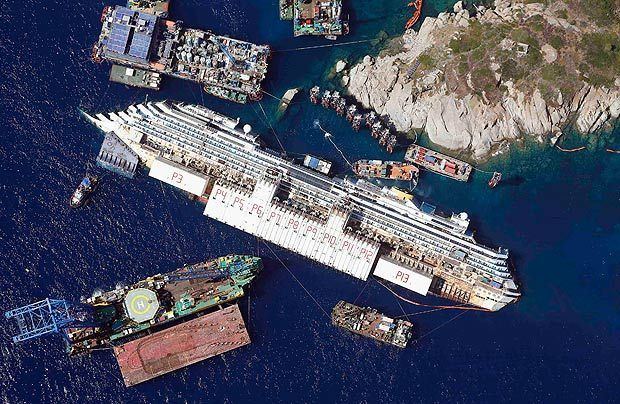 | ||
Propulsion Diesel-electric transmission | ||
Costa concordia cruise ship disaster 2012 a ship off course
Costa Concordia ([ˈkɔsta konˈkɔrdja]) was a Concordia-class cruise ship built in 2004 by the Fincantieri's Sestri Ponente yards in Italy and operated from 2005 until 2012 by Costa Crociere (a subsidiary of Carnival Corporation). It was wrecked off the coast of Isola del Giglio in Italy on 13 January 2012. The ship was damaged due to a contact with a submerged rock and capsized hours later and was subsequently declared a total loss and later towed to the port of Genoa where scrapping operations began. The name Concordia was intended to express the wish for "continuing harmony, unity, and peace between European nations."
Contents
- Costa concordia cruise ship disaster 2012 a ship off course
- Costa concordia savona liguria italy europe
- Concept and construction
- Description
- Layout
- Amenities
- 2008 bow damage
- 2012 grounding and partial sinking
- Salvage
- Culture and media
- References
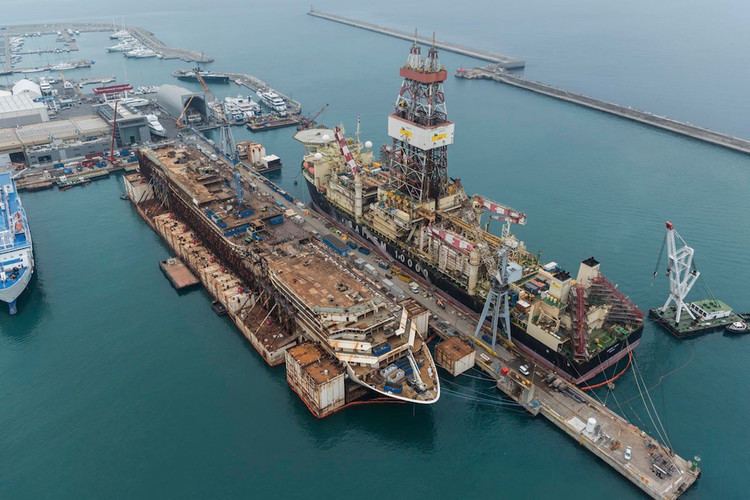
Costa Concordia was the first of the Concordia-class cruise ships, followed by similar ships Costa Serena, Costa Pacifica, Costa Favolosa and Costa Fascinosa, and Carnival Splendor built for Carnival Cruise Lines. When the 114,137 gross tonnage (GT) Costa Concordia and its sister ships entered service, they were among the largest ships built in Italy until the construction of the 130,000 GT Dream-class cruise ships.
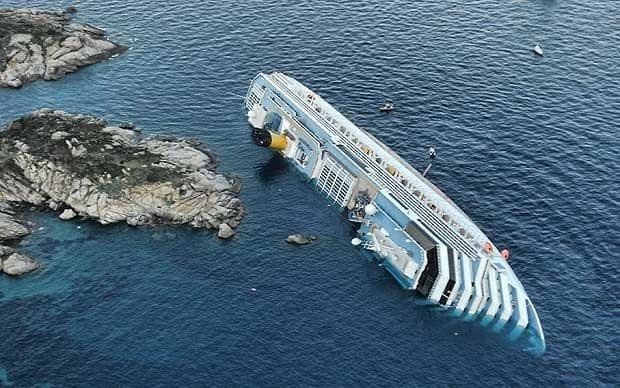
On 13 January 2012 at 21:45, in calm seas and overcast weather, under command of Captain Francesco Schettino, Costa Concordia struck a rock in the Tyrrhenian Sea just off the eastern shore of Isola del Giglio, on the western coast of Italy about 100 km (62 mi) northwest of Rome. This tore open a 50 m (160 ft) gash on the port side of her hull, which soon flooded parts of the engine room resulting in power losses, leading to a loss of propulsion and loss of electrical systems, which crippled the ship. With water flooding in and the ship listing, she drifted back to Giglio Island where she grounded 500 m (550 yd) north of the village of Giglio Porto, resting on her starboard side in shallow waters with most of her starboard side under water.

Despite the gradual sinking of the ship, its complete loss of power, and its proximity to shore in calm seas, an order to abandon ship was not issued until over an hour after the initial impact. Although international maritime law requires all passengers to be evacuated within 30 minutes of an order to abandon ship, the evacuation of Costa Concordia took over six hours and not all passengers were evacuated. Of the 3229 passengers and 1023 crew known to have been aboard, 32 died.
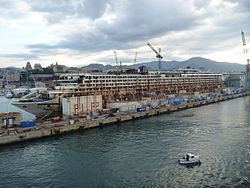
Costa concordia savona liguria italy europe
Concept and construction
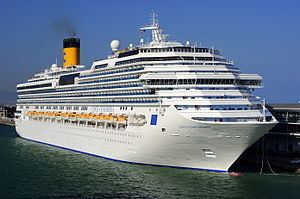
Costa Concordia was ordered in 2004 by Carnival Corporation from Fincantieri and built in the Sestri Ponente yard in Genoa, at yard number 6122. At the vessel's launch at Sestri Ponente on 2 September 2005, the champagne bottle, released by model Eva Herzigová, failed to break when swung against the hull the first time, an inauspicious omen in maritime superstition. The ship was delivered to Costa on 30 June 2006. It cost €450 million (£372 million, US$570 million) to build.
Description

Costa Concordia was 290.20 metres (952 ft 1 in) long, had a beam of 35.50 m (116.5 ft) and drew 8.20 m (26.9 ft) of water. She had a diesel-electric power plant consisting of six 12-cylinder Wärtsilä 12V46C four-stroke medium-speed diesel generating sets with a combined output of 76.6 MW (102,780 hp). These main generators provided power for all shipboard consumers from propulsion motors to hotel functions like lighting and air conditioning. The ship was propelled by two 21-megawatt electric motors coupled to fixed-pitch propellers. Her design service speed was 19.6 knots (36 km/h; 23 mph), but during sea trials, she achieved a speed of 23 knots (43 km/h; 26 mph).
Layout
Costa Concordia had 13 public decks; Deck 1 was the lowest:
Amenities
Costa Concordia was outfitted with approximately 1,500 cabins; 505 with private balconies and 55, with direct access to the Samsara Spa, that were considered Spa staterooms; 58 suites had private balconies and 12 had direct access to the spa. Costa Concordia had one of the world's largest exercise facility areas at sea, the Samsara Spa, a two-level, 6,000 m2 (64,600 sq ft) fitness center, with gym, a thalassotherapy pool, sauna, Turkish bath and a solarium. The ship had four swimming pools, two with retractable roofs, five jacuzzis, five spas, and a poolside movie theatre on the main pool deck.
There were five on-board restaurants, with Club Concordia and Samsara taking reservations-only dining. There were thirteen bars, including a cigar and cognac bar and a coffee and chocolate bar.
Entertainment options included a three-level theatre, casino, a futuristic disco, and a children's area equipped with video games. She also had aboard a Grand Prix motor racing simulator and an internet café.
2008 bow damage
On 22 November 2008, Costa Concordia suffered damage to her bow when high winds over the Sicilian city of Palermo pushed the ship against its dock. There were no injuries and repairs started soon after.
2012 grounding and partial sinking
On 13 January 2012, after departing Civitavecchia, the port for Rome, Italy, on a 7-night cruise, at 21:45 local time (UTC+1), Costa Concordia hit a rock off Isola del Giglio (42°21′55″N 10°55′17″E). A 53-metre (174 ft) long gash was made in the port-side hull, along 3 compartments of the engine room (deck 0); power from the engines and ship services ceased. Taking on water, the vessel listed to the port side. Twenty-four minutes later, strong winds pushed the vessel back towards the island. The water in the ship poured into the starboard side of the ship, causing it to reverse list to starboard.
Without power, the ship drifted astern, listing heavily to starboard. Costa Concordia drifted back and grounded near shore, then rolled onto her starboard side, lying in an unsteady position on a rocky underwater ledge. Almost half of the ship remained above water, but it was in danger of sinking completely into a trough 70 metres (230 ft) deep.
She was carrying 3,206 passengers and 1,023 crew members, all but 32 of whom were rescued; as of 22 March 2012, 30 bodies had been found, with two people known to be missing and presumed dead. There may have been other people not listed on board. The search for bodies was canceled at the end of January and resumed after the parbuckling manoeuvre in September 2013, after which additional remains were found. On 26 September 2013, remains were found on deck 4, and were reported as being the two passengers reported as missing. The following day, the remains were found not to be from the missing passengers. In October 2013, the body of one of the missing passengers was found and confirmed to be that of Maria Grazia Trecarichi. Scuba divers had discovered her body near the third deck of the salvaged ship.
An investigation focused on shortcomings in the procedures followed by the crew and the actions of the Italian captain, who allegedly left the ship prematurely. About 300 passengers were left on board, most of whom were rescued by helicopter or motorboats in the area. The nature of the accident also prompted the media to immediately draw striking comparisons to the Sinking of the RMS Titanic of a century earlier. This led to rumors that some survivors who were in one of the restaurants, stated that they heard "My Heart Will Go On" (theme song of the Oscar-winning 1997 film Titanic) playing on the restaurant's speakers the moment the ship struck the rock.
Salvage
An initial assessment by salvage expert Smit International estimated that the removal of Costa Concordia and her 2,380 tonnes of fuel could take up to 10 months. Smit advised that the ship had been damaged beyond the hope of economical repair and recommended it be written off as a constructive total loss. Smit was soon contracted to initially remove only Concordia's fuel.
During the fuel removal operation, Smit reported that the ship had shifted 60 cm (24 in) in the three weeks since her grounding but that there was no immediate prospect of her breaking up or sinking deeper. Removal of the fuel from the various fuel tanks distributed throughout the ship was completed in March 2012, later than Smit's initial estimates. This cleared the way to arrange for the ultimate salvaging and scrapping of the ship.
It was announced on 21 April 2012 that the American salvaging firm Titan Salvage and Italian underwater construction firm Micoperi would attempt to refloat and remove the wreck, so it can be safely broken up in port, in the largest ship refloating project. It was later announced in May 2012 that they had won the salvage contracts following competitive bidding. The salvage plan included the following operations:
On 17 September 2013, Costa Concordia was brought to a vertical position through a parbuckling procedure. The cost for salvaging the ship increased to $799 million. In addition, the ship had suffered severe hull deformations in two places. Titan Salvage, the company directing the salvage operations, estimated that the next phase of the salvage operation would be completed by early-to-mid-2014. After this "floating" operation, the ship would be towed to a salvage yard on the Italian mainland for scrapping or "breaking".
On 14 July 2014, work commenced to refloat Costa Concordia in preparation for towing. At this point, the costs had risen to 1 billion euros. Including tow cost, 100 million for the ship to be broken up for scrap and the cost of repairing damage to Giglio island, the estimated final cost was expected to be €1.5 billion ($2 billion). On 23 July, having been refloated, the ship commenced its final journey under tow and a 14-ship escort at a speed of 2 knots (4 km/h; 2 mph) to be scrapped in Genoa. It arrived at port on 27 July, after a 4-day journey. It was moored to a seawall at the port, awaiting dismantling processes.
On 11 May 2015, following initial dismantling but still kept afloat by the salvage sponsons, the hull was towed 10 miles (16 km) to the Superbacino dock in Genoa for removal of the upper decks. The last of the sponsons were removed in August 2016 and the hull was taken in to a drydock on 1 September for final dismantling.
Culture and media
In 2010, Costa Concordia provided the decadent setting for Jean-Luc Godard's film Socialisme.
A documentary broadcast in the United Kingdom, titled Terror at Sea: The Sinking of the Costa Concordia, and another first broadcast on 11 April 2012 on Channel 4, titled The Sinking of the Concordia: Caught on Camera, featured footage recorded by the passengers and crew.
A documentary titled Cruise Ship Disaster: Inside the Concordia, was first broadcast on the Discovery Channel, CNN Presents: Cruise to Disaster, first broadcast by CNN on 14 July 2012, and another, titled Inside Costa Concordia: Voices of Disaster, was first broadcast by the National Geographic Channel. The season 39 Nova episode "Why Ships Sink" discusses the sinking of Costa Concordia. A later Nova season 42 episode "Sunken Ship Rescue" featured the salvage effort and race to refloat and remove the badly damaged Costa Concordia from the accident scene before the ship could break apart, risking an environmental catastrophe.
ABC's 20/20 aired a special on the sinking and interviews with the survivors on 15 February 2013, following the engine fire on Carnival Triumph.
The wreckage of Costa Concordia also featured in Paolo Sorrentino's 2013 film The Great Beauty.
"The Ballad of the Costa Concordia," written by Will Toledo, is featured on indie rock band Car Seat Headrest's 2016 album Teens of Denial. It uses the disaster as a metaphor for a personal breakdown.
